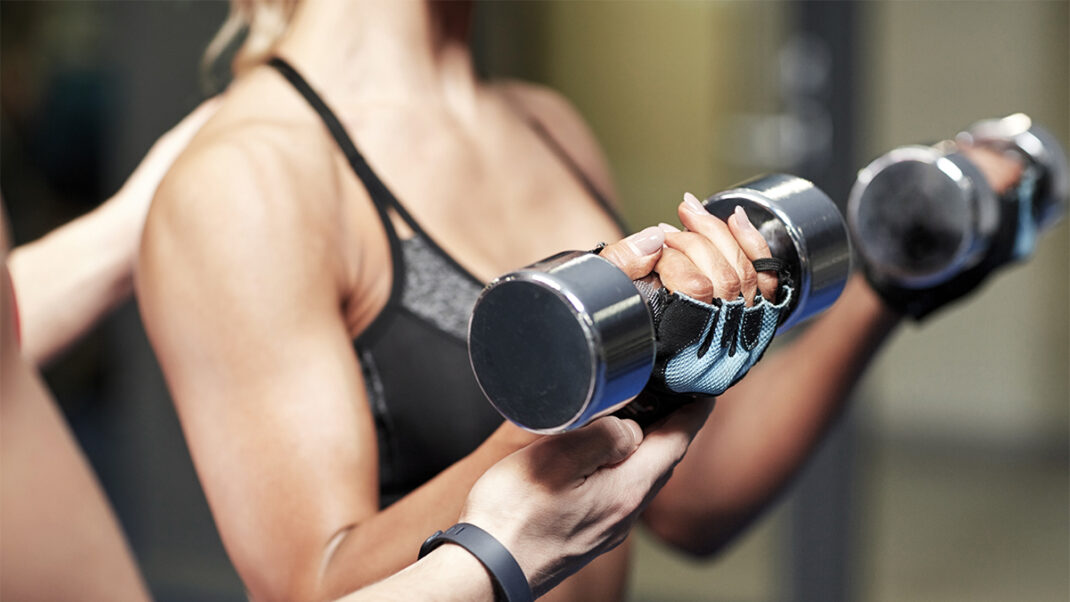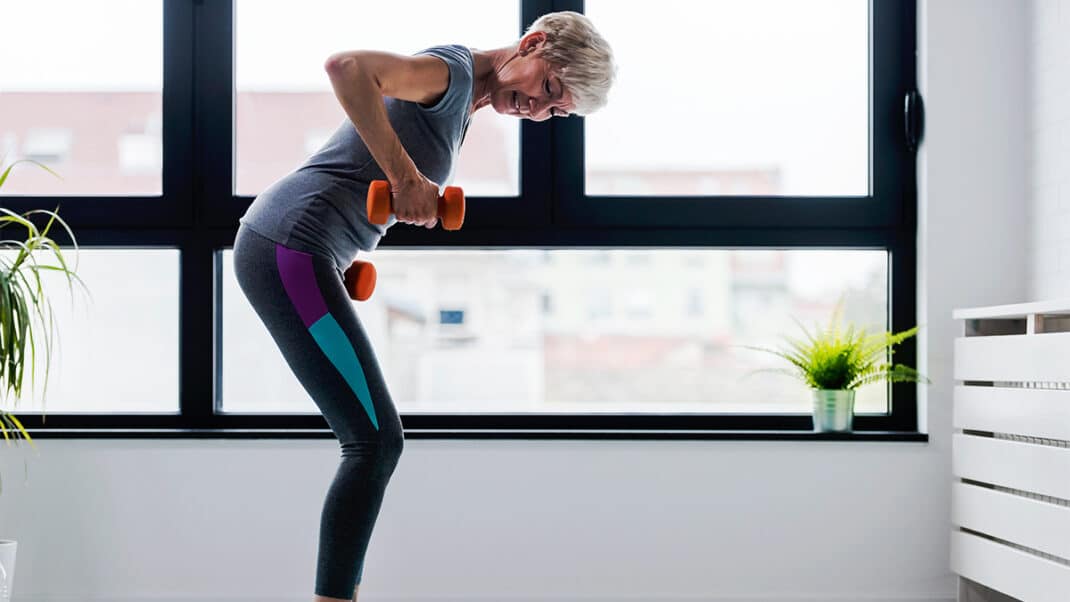Sample Class: Dance-Inspired Cardio
Give students an excuse to lose themselves in music.
As group exercise studios fill with myriad equipment options, a class that relies only on great music, a motivating instructor and a room full of eager participants is a refreshing change. “Dance-Inspired Cardio” blends familiar high-low steps with mambos, chassés, leaps, holds, kick-ball changes, turns and cha-chas for a dance-like experience. When students feel that they’re dancing, they lose themselves in the sheer pleasure of moving and reap the cardiovascular benefits. This can be the most fun some people have all week.
The primary goal in a dance-based class is to respect it as a cardiovascular activity designed to raise the heart rate; however, students can still feel that they’re performing. Don’t worry if you have little or no dance background. You don’t have to move like Janet Jackson or Justin Timberlake (I know I can’t!). Just make sure you teach a routine that helps students succeed. The most elaborate routine goes unappreciated if no one can do it!
Format: cardio dance
total time: approximately 60 minutes
equipment Needed: a mat if you are going to include core work; otherwise, no equipment necessary
Music: 135–55 bpm
Music selection and speed depend on style, movement complexity and the number of double-time rhythms used.
Start with a simple combination to acclimate bodies and to pull everyone in. Allow students to feel successful early on. As the choreography gets more elaborate, participants will feel less discouraged because they have already experienced success. On the other hand, if you confuse a student in the beginning, you might lose her permanently. First impressions are lasting! Include a rhythmic and dynamic stretch if you feel it will help prepare the class mentally.
Combination 1
Final Product:
- rock behind on each side (10 counts)
- 6-count mambo
- alternating knees (8 counts)
- mambo chassé, double pivot turn (8 counts)
Instruction: Start by marching. Change the march to a double march right and a double march left, followed by 6 counts of marching in place. Next, transform the 6-count march into a 6-count mambo. Introduce alternating knees. Take it from the top; hold alternating knees for 16 counts.
Teach a mambo chassé on each side. Add a 4-count march after the chassé. Change the 4-count march to a mambo (option: change the mambo to a pivot turn). Put everything together from the top. Optional final layer: Step behind on the double march.
Note: Everything in this combination is symmetrical. Introduce each movement in order, teaching the 8 counts with the lead-leg change last.
Combination 2
Final Product:
- march forward (4 counts)
- box step on count 5, moving back; box step again on count 8, followed by a 6-count mambo (16 counts)
- pivot turn on counts 1 and 2; chassé to the back twice on counts 3 and 4, 5 and 6; mambo on counts 7 and 8 (8 counts)
- chassé forward on counts 1 and 2; march or turn on counts 3 and 4, 1 V-step (4 counts)
Instruction: Teach the second half first since the second 16 counts have the lead-leg change. Start by teaching the rhythm: 2 counts of marching, two chassés, two marches, and then a chassé and a 4-count march. Once the rhythm is established, add the directional change. The rhythm must be set first because when you add direction, participants face the back of the room.
Introduce 16 counts of marching before the second half of the combo. Layer the box step on counts 5 and 8, followed by the 6-count mambo. Move the first 4 counts of the marching forward, and use the box step to move backward. Optional final layer: Add a turn to the 2-count march after the forward-moving chassé.
Combination 3
Final Product:
- starburst 2x, extension march back (8 counts)
- grapevine, double lunge back (6 counts)
- single knee lift 2x, turn back (4 counts)
- grapevine, double lunge back (6 counts)
- single knee lift 2x, turn back (4 counts)
- chassé rock back (4 counts)
Instruction: Teach a step out, abducting the leg and marching for 2 counts (“starburst”). Repeat on the other side. Take the moves high or low to add intensity. Next, teach four grapevines, four single and four double curls on each side. Change the order so that after the grapevines you do the double curls first. Change the order again so that you have one double curl, two single curls, one double curl, two single curls. Change the double curl to a lunge back. Change the order again so that the lunge back goes at the end of the grapevine, followed by single curls. Layer the single curls with a curl that turns to the back.
Return to the top of the sequence (starburst, grapevine, etc.) and finish with 4 counts of step-touches. Introduce the chassé rock back. Go back to the top, replacing the step-touches with a chassé rock back. Repeat on left.
Combination 4
Final Product:
- chassé on the diagonal 3x, pivot turn (8 counts)
- stomp 2x (4 counts), mambo (4 counts)
- chassé on counts 1 and 2, plant foot on count 3, lift foot on count 4 and place foot down on count 5; minimambo on counts 6, 7 and 8
- minimambo 2x, turn (8 counts)
Instruction: Do the chassé on the diagonal three times with the pivot turn, which changes the lead leg. You will face the back diagonal at the end, so teach the next part facing forward to establish the move. This will help ensure that everyone sees the movement before you change directions. Add the movement with the directional change. If appropriate, add the turn after the last minimambo, but only at the very end.
Teach a very simple, rhythmic routine to allow the heart rate to come down slowly. Spend at least 5 minutes stretching the major muscle groups used in the workout. You may also incorporate 5–7 minutes of core work.
Everyone has a dancer inside just clawing to get out. Open the door, turn up the beat, and let everyone feel comfortable moving their feet. n
- Know the base moves (for example, the base move of a 6-count mambo and knee is a march and knees).
- Recognize where the lead leg changes, and build from there.
- Take your time breaking down the movements.
- Layer, layer, layer (and don’t be afraid to go back to an earlier layer).
- Make one choreography change at a time.
- Don’t rush your breakdowns.
- Keep a close eye on your students; stop adding complexity if you start losing them.
- Enjoy the process—it’s all cardio!
- Build natural lead-leg changes into your combinations for less cuing and better flow.
- One way to get comfortable teaching a dance-influenced class is to use Latin music. You can’t help but dance!
Rob Glick
Rob Glick is an internationally-acclaimed fitness professional and a professional fitness consultant for Global Fitness Solutions. He is the recipient of Can-Fit-ProÔÇÖs 2006 International Presenter of the Year award and ECAÔÇÖs 2005 Best Male Presenter award. He holds a bachelorÔÇÖs degree in exercise science, and is a star trainer on Exercise TV, a leader of many fitness videos, and a master trainer for efi GRAVITY┬« Training, BOSU┬« and Schwinn┬« Cycling.






